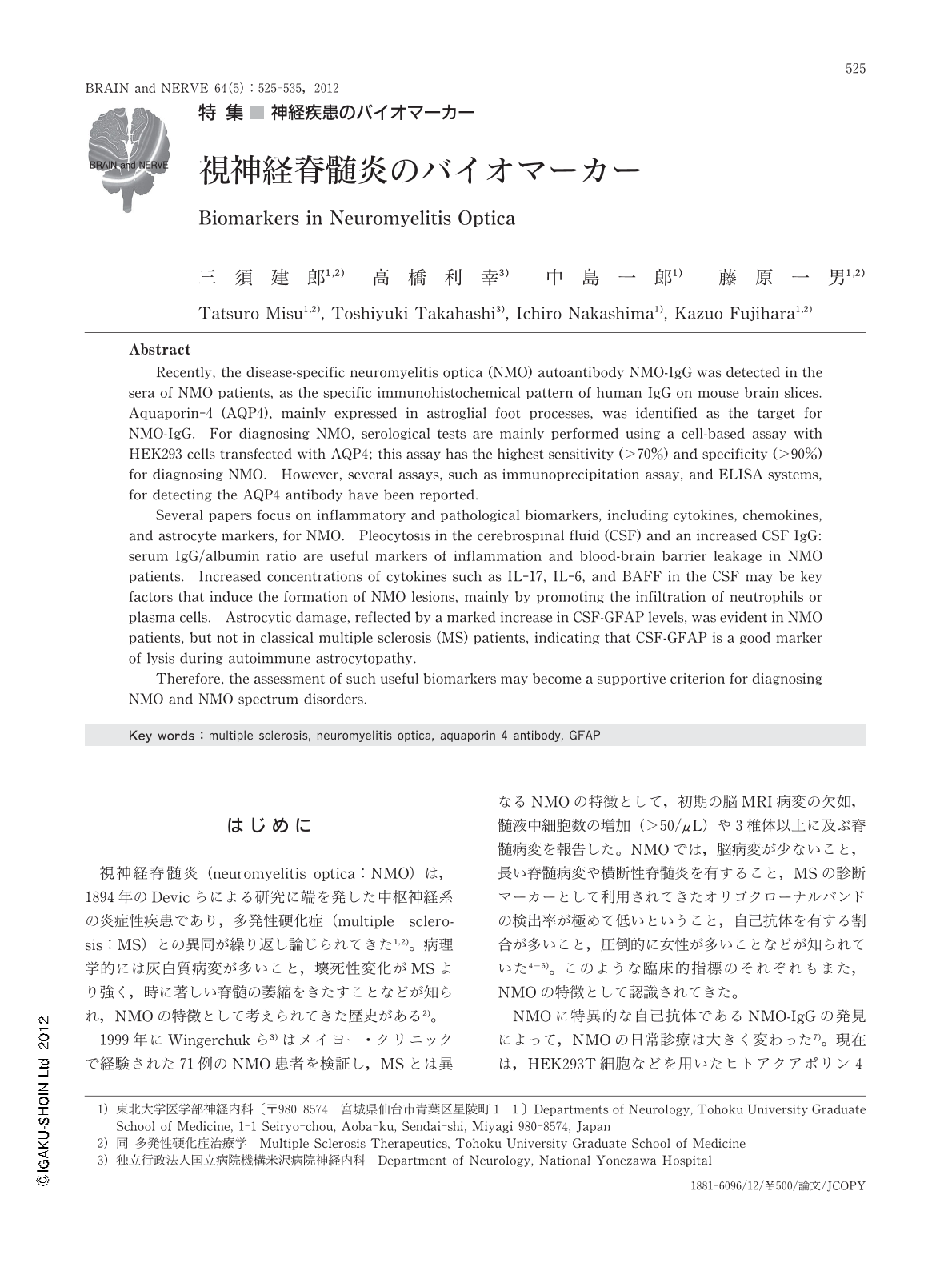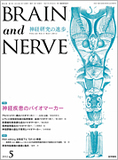Japanese
English
- 有料閲覧
- Abstract 文献概要
- 1ページ目 Look Inside
- 参考文献 Reference
はじめに
視神経脊髄炎(neuromyelitis optica:NMO)は,1894年のDevicらによる研究に端を発した中枢神経系の炎症性疾患であり,多発性硬化症(multiple sclerosis:MS)との異同が繰り返し論じられてきた1,2)。病理学的には灰白質病変が多いこと,壊死性変化がMSより強く,時に著しい脊髄の萎縮をきたすことなどが知られ,NMOの特徴として考えられてきた歴史がある2)。
1999年にWingerchukら3)はメイヨー・クリニックで経験された71例のNMO患者を検証し,MSとは異なるNMOの特徴として,初期の脳MRI病変の欠如,髄液中細胞数の増加(>50/μL)や3椎体以上に及ぶ脊髄病変を報告した。NMOでは,脳病変が少ないこと,長い脊髄病変や横断性脊髄炎を有すること,MSの診断マーカーとして利用されてきたオリゴクローナルバンドの検出率が極めて低いということ,自己抗体を有する割合が多いこと,圧倒的に女性が多いことなどが知られていた4-6)。このような臨床的指標のそれぞれもまた,NMOの特徴として認識されてきた。
NMOに特異的な自己抗体であるNMO-IgGの発見によって,NMOの日常診療は大きく変わった7)。現在は,HEK293T細胞などを用いたヒトアクアポリン4(aquaporin 4:AQP4)特異的抗体の検出法やenzyme-linked immunosorbent assay(ELISA)法などが開発され,感度・特異度には違いがあるものの,おおよそ70%前後の感度と90%以上の特異度をもって国際的にNMOの診断が行われるようになっている8)。NMO-IgGは診断だけではなく治療の選択においても非常に重要な意味がある。NMO-IgG陽性例ではMSで第一選択薬として使われてきたインターフェロン(interferon:IFN)療法ではかえって病態を悪化させる症例が多く,初めに選択すべき治療ではないことは既に周知された事実である9-12)。また,AQP4抗体以外にもNMOの臨床病勢や免疫病態を理解するうえでの有用なバイオマーカーが数々報告されるようになってきている。
本稿では,NMOの診断や治療などについては他の優れた文献に譲り,近年問題となっているAQP4抗体の検査法や神経傷害マーカーとしてのアストロサイト関連マーカーの意義,病態を反映する数々のサイトカインなどに焦点を当てることとする。
Abstract
Recently, the disease-specific neuromyelitis optica (NMO) autoantibody NMO-IgG was detected in the sera of NMO patients, as the specific immunohistochemical pattern of human IgG on mouse brain slices. Aquaporin-4 (AQP4), mainly expressed in astroglial foot processes, was identified as the target for NMO-IgG. For diagnosing NMO, serological tests are mainly performed using a cell-based assay with HEK293 cells transfected with AQP4; this assay has the highest sensitivity (>70%) and specificity (>90%) for diagnosing NMO. However, several assays, such as immunoprecipitation assay, and ELISA systems, for detecting the AQP4 antibody have been reported.
Several papers focus on inflammatory and pathological biomarkers, including cytokines, chemokines, and astrocyte markers, for NMO. Pleocytosis in the cerebrospinal fluid (CSF) and an increased CSF IgG: serum IgG/albumin ratio are useful markers of inflammation and blood-brain barrier leakage in NMO patients. Increased concentrations of cytokines such as IL-17, IL-6, and BAFF in the CSF may be key factors that induce the formation of NMO lesions, mainly by promoting the infiltration of neutrophils or plasma cells. Astrocytic damage, reflected by a marked increase in CSF-GFAP levels, was evident in NMO patients, but not in classical multiple sclerosis (MS) patients, indicating that CSF-GFAP is a good marker of lysis during autoimmune astrocytopathy.
Therefore,the assessment of such useful biomarkers may become a supportive criterion for diagnosing NMO and NMO spectrum disorders.

Copyright © 2012, Igaku-Shoin Ltd. All rights reserved.


